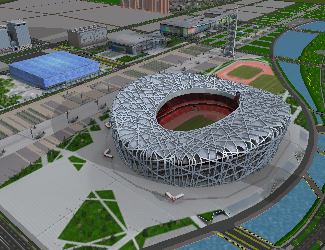Instructions for use
SuperMap iDesktopX can obtain the shadow positions of data in the scene based on the position of the light source (sun), simulating the shadow effect of data in the scene. The shadow mode needs to be used in conjunction with the Visible function in the Scene tab. After enabling the shadow effect, the display direction of object shadows is related to the current scene time and not to the current computer time. The current scene time can be viewed or modified in the Track management panel under the Scene tab. For specific operations, please refer to Sun Effect.
Currently, 3D tile layers (with models as source data), 2D point/line/region layers, 3D point/line/region layers, and model layers support setting the shadow mode. Among them, the shadow mode for 2D region layers is typically applied to region datasets and thematic map layers with extrusion height set, while point (line) layer shadows are usually applied to point (line) layers where point (line) symbols are set as 3D symbols.
Function Entry
- Layer Manager->Layer Context Menu->Shadow Model
- Scene tab->Properties module->Layer Properties button->Layer Properties panel->Basic module->Shadow Model
Operation Steps
- Create or open a scene, and load the target data into the scene window.
- The shadow effect requires activating the Sun Effect before it can be displayed. Before adjusting the shadow mode, activate the Sun Effect via the Visible button in the Browse group under the Scene tab, and adjust the time using the Track button to dynamically adjust the shadow effect.
- Adjust the shadow mode of the layer as needed using any of the following methods:
- Method 1: In the Layer Manager, select the target layer and right-click. Choose Shadow Mode from the context menu. Options include No Shadow, Show Selected Object Shadows, and Show All Object Shadows.
- No Shadow: Selecting this option means no shadows of objects in the layer are displayed.
- Show Selected Object Shadows: Selecting this option displays the shadows of selected objects in the layer.
- Show All Object Shadows: Selecting this option displays the shadows of all objects in the layer.
- Method 2: In the Layer Manager, select one or more layers. In the Properties group of the Scene tab, click the Layer Properties button to open the Layer Properties panel. In the Basic module, click the drop-down button next to "Shadow Mode" to make settings.
- Method 1: In the Layer Manager, select the target layer and right-click. Choose Shadow Mode from the context menu. Options include No Shadow, Show Selected Object Shadows, and Show All Object Shadows.
- After adjustment, the shadow effect will be displayed in the scene. The following image shows a schematic diagram of model shadows.




